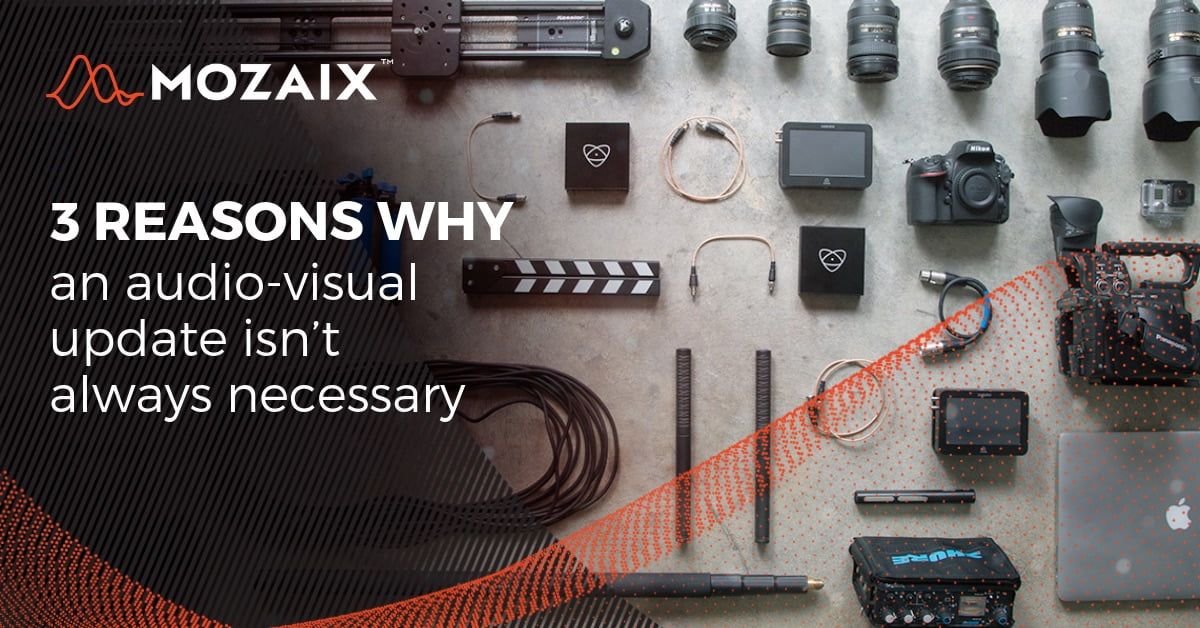
3 reasons why an audio-visual update isn’t always necessary
Many people make the mistake of opting for an AV upgrade based on attractive technology, without assessing the necessity based on the venue and at a human level.
As the host of many types of events or functions, the goal of every venue is to create an atmosphere and experience where attendees are truly connected and engaged. In an effort to enhance the experience, many venues look at updating their audio-visual gear hoping it will make a difference.
Sometimes, an update isn’t necessary. It is important to assess what you are wanting to achieve with new technology, or to seek advice from a professional, before you spend thousands of dollars on an upgrade. The technology world will tell you, that you need the next best thing. Because of this, too many venues have the belief that their dated gear won’t provide. Whilst our job consists mostly of upgrades, it is also our responsibility to help our clients think through how to maximise results from their current equipment, and select wisely when it comes to upgrades.
And frankly, a lot of upgrades we see are unnecessary, and here are the common reasons why:
#1 – Expensive PA’s will still sound bad if the room is acoustically flawed
Before you spend up big on the latest digital desk with onboard effects and a 15-speaker line array PA, it is important to consider the acoustics of the venue first.
Many factors can affect room acoustics, such as parallel walls, reflective surfaces, position of the PA etc. Sometimes it may be a matter of spending a proportion of your budget on a sophisticated acoustic treatment assessment with an Acoustic Consultant, you will be amazed at how appropriate use of diffusers or even carpet flooring will do your room wonders. You can find more about how to improve the acoustics of your room or venue here.
With some acoustic treatment, no matter how dated your current gear is, you can create a very different audio experience within your venue.
The quality of sound in a venue is not dependant on what comes out of the speakers, but also how the sound is absorbed and reflected around the room.
#2 – There’s nothing wrong with Analogue
Many people that currently use analogue make the mistake of upgrading their equipment to digital, when they may not need to.
Take for instance a sound desk. Whilst the thought of upgrading an analogue sound desk to a digital one sounds appealing, from a functional point of view, both mostly achieve the same goal in sound technology.
If you are operating a sound desk with a group of volunteers who are used to using analogue, and know which knobs control certain things, a change to digital would require training and will most likely confuse them.
Digital and analogue both have their places, depending on the need and situation. More information on the different needs can be found here in an article written by Sapphire Sound.
When considering an upgrade, consider user experience before technology.
#3 – In this for the long haul
Technology is supposed to make life easier; but let’s admit it, we’ve all been at the mercy of incompatible technology that incurs extra maintenance, optimisation, even more upgrades down the track.
One of the most important considerations when we do an install, is to minimise unexpected maintenance headaches. Yes, any technology will need ongoing maintenance, but well-designed systems will always be rock solid when it comes to stability and durability.
For example, in the world of mobile devices, it may seem easy and affordable to go for iPad controlled systems. The downside of that, is software updates and clashes between new software on old hardware, and anything in between. Imagine if that happens in the middle of a show, and it won’t be pretty.
Sometimes however, switching to digital might be the right way to go, especially when you have volunteers or non-professionally trained operators.
The beauty of digital is that it allows you to have pre-sets with restricted controls; for example, if your venue is mostly run via speaker from a lectern, you may want to have a preset where the operator only has access to the voice fader plus BDM, that’s it. No messing around with EQ, compression, given those are all well-set within the program.
But the big idea is all about sustainability, otherwise there will be a big bill from AV companies every quarter for more gear and fixing glitches.
Audio-visual upgrades have their place, however consider first the need for it and ask yourself: ‘What am I trying to achieve with an upgrade? At Mozaix, we are passionate about assisting our clients with advancing their technology goals. This does not always mean an upgrade; but working with the existing technology if there is a need for it.
Before your next audio-visual upgrade, consider the acoustics of the room, the user experience, and the sustainability of what you’re trying to achieve. For professional and honest advice on your audio-visual goals, visit the Mozaix website here, and contact our team of experts.